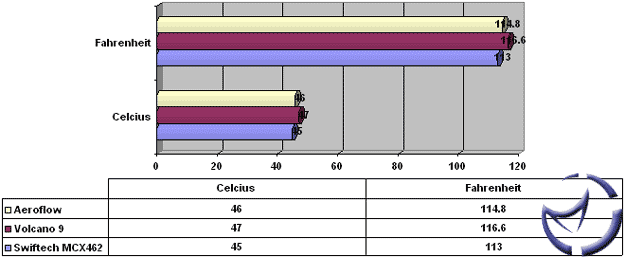|
  
One thing Vantec has always been admired for is their excellent HSF mounting system, and the Aeroflow does not dissapoint. You may need to use a flathead screwdriver, but no need to worry about gauging out your motherboard as there is a screwdriver slot to use. Being the macho-guy that I am, I was able to install the heatsink without any tools.
Both ends of the clip use all three mounting prongs on the Socket-A socket. This is useful for a couple reasons. For one thing, it provides a very secure installation, and you won't need to worry about the heatsink shifting while moving your case around. The other benefit is if you've broken a prong in a previous heatsink install, you can still use this heatsink.
Performance
Athlon XP 1700+ (Provided by )
Nanotherm Ice Thermal Compound
Prime95 run for 20 minutes
Room temperature is maintained at ~23C/74F
The competition will be the Swiftech MCX462, as well as the Thermaltake Volcano 9. We chose the Volcano 9 since it uses a similar copper slug/aluminum heatsink combo, and outfitted it with the Smart Fan 2. The Swiftech MCX462 has been our best performing heatsink for well over a year, and I've yet to test a better cooler than this one. The Swiftech is also outfitted with a Smart Fan 2. For the first set of tests, the Smart Fan will be run at the "low" setting to match the noise level of the TMD fan. To keep is fair for the competition, the second test will have both heatsinks to run with the fan at the maximum speed setting.
Test One

At the low settings, the Aeroflow easily beats out the two other heatsinks. To be fair now, the TMD fan does push a lot more air than the Smart Fan 2 at the low setting. I mentioned the low setting test was used to keep the sound levels close to the TMD fan, but truth is, they were near silent, whereas the TMD fan is noticably louder. I'll follow up the noise discussion after the second test...
Test 2

With the Smart Fan 2 spinning at full speed, the Swiftech barely squeezes by the Aeroflow, which in turn manages a narrow victory over the Volcano 9. Going back to the noise argument, although the Smart Fan 2 is moving a lot of air at this speed, it is unbearably loud. The TMD in comparison is a lot more quiet. My conclusion? Using a slower spinning fan, the Vantec Aeroflow manages to hang right in there, which is a testament to its heatsink design.
Overclocking
The Aeroflow does an amazing job when running a CPU at stock speeds, but I doubt the majority of you settle for stock. The Athlon XP 1700+ runs at a default of 1.4GHz. I typically run at 8x166, which in MHz equals 1328. The Aeroflow had little problem with this speed, staying at about 50C under load. At 8x168, I was unable to boot past the POST, and the system kept locking up. In contrast to the Swiftech, which would hover about 48C at 8x166, and boot into Windows (though the system would still occasionally lockup) at 8x168.
I should probably add that this isn't really overclocking, as the raw MHz is actually 1328. The FSB is OC'd but since some of you have asked, I ran some more tests and found that 10.5x150 worked with the Vantec, whereas 10.5x151 was a little flakey. The Swiftech on the other hand became unstable at about 154.
Final Words
At the risk of sounding like a fan-boy, Vantec have themselves one heck of a cooler. It's very well designed, from its copper core placement, to its windtunnel effect, to it's mounting mechanism. The matchup with the TMD Fan seems to be a good idea, as its cooling properties seem to be a perfect match with the heatsink.
Normally, this level of craftsmanship comes with a price, and Vantec manages to package all of this for about 27$ at . This also includes the TMD fan which normally retails for about 12$ or so. Not bad. For our European readers, you can also grab this at for £22.95 (exc. VAT).
I'm trying to find a shortcoming, but I honestly have nothing bad to say about it. Sure, it'd be nice if the heatsink were bigger I suppose, and an 80mm TMD Fan would be great, but that'd just make for a more expensive package. I have heard that there was a recall of TMD fans, but from my research, Vantec uses the newer revisions that don't have the same problems as the initial batch of fans.
Overclocking went well, except when we went for the higher overclocks. Perhaps a monster sized 70mm fan would have helped, but I'm not aware of any that exist.
That being said, if you're in the market for a well priced cooler that performs well, the Aeroflow is certainly one I would highly recommend.
Pros: Great performance. Good engineering, and aesthetic design. Heatsink clip is great also.
Cons: Overclocking results were average.
Bottom Line: It's not the best performing heatsink out there, but it's one of the cheapest when you consider the quality, and the noise/performance ratio is great for an air cooler. It's a snap to install, and they include some pretty good thermal paste as well (we'll be following up on that in a future article).

Agree? Disagree? Discuss it in our forums
Previous Page - Introduction
Home
|
